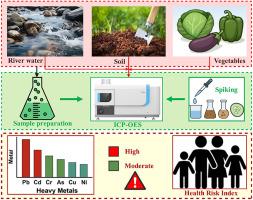加纳贝桂市丹克兰河沿岸灌溉用水、土壤和蔬菜重金属污染及健康风险综合评估
IF 8.1
2区 环境科学与生态学
Q1 ENVIRONMENTAL SCIENCES
引用次数: 0
摘要
工业活动向生态系统释放了大量污染物,对人类和野生动物都构成了潜在威胁。该研究调查了加纳贝桂市的水污染情况,重点关注丹克兰河的灌溉水及其对农业土壤和栽培蔬菜中有毒金属积累的影响。利用ICP-OES分析了水、土壤和蔬菜样品的理化性质和重金属含量。虽然灌溉水的电导率(151.58±62.35 μS/cm)和总溶解固形物(132.22±51.88 mg/L)是安全的,但总悬浮固形物(2744.44±1039.43 mg/L)、颜色(25353.33±5707.37 Pt/Co)和浊度(2916.67±617.36 NTU)的高水平引起了农业使用的担忧。灌溉水中的铬(0.42±0.13毫克/升)和砷(0.38±0.13毫克/升)浓度超过了世卫组织/粮农组织的标准,土壤样品中这些金属的含量也很高(铬:84.31±36.40;砷:59.90±17.60),引起了人们对食品安全的担忧。虽然蔬菜中的重金属含量总体上符合安全标准,但白菜和菜园鸡蛋中的砷含量一直高于安全标准。土壤对蔬菜的重金属转移量大多较低,但镉表现出中等但安全的转移性。健康风险评估发现,对当地蔬菜消费者没有重大风险,镍构成的威胁最低。此外,砷是健康指数和癌症风险的主要因素。可持续的水和土壤管理对于防止农业中的重金属污染至关重要,因此必须定期监测小型采矿和废物处理场附近的地表水。本文章由计算机程序翻译,如有差异,请以英文原文为准。

Integrated assessment of heavy metal contamination and health risks in irrigation water, soil, and vegetables along the Dankran River, Bekwai Municipality, Ghana
Industrial operations release significant amounts of pollutants into the ecosystem, introducing potential threats to both humans and wildlife. The study examined water contamination in the Bekwai Municipality, Ghana, with a focus on the Dankran River's irrigation water and its impact on the accumulation of toxic metals in agricultural soils and cultivated vegetables. Water, soil, and vegetable samples were analysed for physicochemical properties and heavy metal content using ICP-OES. While the electrical conductivity of the irrigation water (151.58 ± 62.35 μS/cm) and total dissolved solids (132.22 ± 51.88 mg/L) were safe, high levels of total suspended solids (2744.44 ± 1039.43 mg/L), colour (25353.33 ± 5707.37 Pt/Co), and turbidity (2916.67 ± 617.36 NTU) raised concerns for agricultural use. Chromium (0.42 ± 0.13 mg/L) and arsenic (0.38 ± 0.13 mg/L) concentrations in irrigation water exceeded WHO/FAO standards, and soil samples also showed high levels of these metals (chromium: 84.31 ± 36.40; arsenic: 59.90 ± 17.60), raising food safety concerns. Although heavy metal levels in vegetables generally met safety standards, arsenic was consistently above safe limits in cabbage and garden eggs. Heavy metal transfer from soil to vegetables was mostly low, except for cadmium, which showed moderate but safe transferability. The health risk assessment found no substantial risk to the local vegetable consumers, with nickel posing the lowest threat. Also, arsenic was the primary contributor to the health index and cancer risks. Sustainable water and soil management is crucial to prevent heavy metal contamination in agriculture, necessitating regular monitoring of surface water near small-scale mining and waste disposal sites.
求助全文
通过发布文献求助,成功后即可免费获取论文全文。
去求助
来源期刊

Chemosphere
环境科学-环境科学
CiteScore
15.80
自引率
8.00%
发文量
4975
审稿时长
3.4 months
期刊介绍:
Chemosphere, being an international multidisciplinary journal, is dedicated to publishing original communications and review articles on chemicals in the environment. The scope covers a wide range of topics, including the identification, quantification, behavior, fate, toxicology, treatment, and remediation of chemicals in the bio-, hydro-, litho-, and atmosphere, ensuring the broad dissemination of research in this field.
 求助内容:
求助内容: 应助结果提醒方式:
应助结果提醒方式:


